Whether you’re just charging your car battery in your garage with a dedicated charger, or if you pop the hood on the side of the road, seeing smoke coming from your car’s battery is NEVER a good sign. There are quite a few variables to consider and several possibilities for the root cause of the problem. Some of the solutions are easy and you can keep your battery, some require a new battery, and some will require a mechanic to do some work on your car.
Let’s take a peek at the top 7 reasons why your car’s battery is smoking so that you can figure out what’s going on and get things back in order!
| Reason for Smoking (Steaming) Battery | Why the Car Battery is Smoking (Steaming) | How to Fix |
|---|---|---|
| Overcharging | Battery cannot convert electrical energy into stored chemical energy fast enough and gets rid of excess current through heat and steam | Use a properly-sized smart charger by keeping the charging amps at 10% or less of the total Ah (ampere hour) rating on the battery |
| Low Electrolyte (Flooded Batteries Only) | Exposed plates heavily sulfate which increases internal resistance. Excess heat is generated which boils off electrolyte and steam will escape | Add just enough distilled water to cover the plates, charge battery with a properly-sized smart charger, when completely charged add more distilled water until you’re just below the fill tubes. |
| Alternator / Voltage Regulator Malfunctioning | If defective, they can overcharge the battery. Excess current will be released as heat which will boil off your electrolyte into visible steam. | Have a mechanic inspect these if you’ve ruled out other issues. Often times, this problem will also be accompanied by the battery light on your dash lighting up, engine stalling, and issues with your lights. |
| Very High Ambient Temperatures | High electrolyte temperatures make the battery very susceptible to overcharging even with proper chargers and alternators under normal temperatures. Overcharging leads to visible steam from the boiling electrolyte. | Replace with an AGM (Absorbed Glass Mat) battery instead of a standard lead acid battery, as they handle higher temperatures better. |
| Overly-Sulfated Battery | Lead sulfate crystals on the plates increase internal resistance and generates heat during charging and discharging and can boil off the electrolyte into visible steam. | Use a charger that has a desulfation mode to dislodge as much of the lead sulfate crystals as possible. Consider replacing the battery if its over 5 years old. |
| Internal Short | “Shock damage” can cause a conductive piece of metal inside the battery to fall between the battery plates and bridge the gap creating a short and will rapidly discharge. This will boil off the electrolyte and release steam from the battery. | Replace the battery. |
| Loose Connections / Terminal Corrosion | Loose connections or corrosion will cause arcing and will also build up lots of resistance and heat. This can melt the battery casing or battery cable insulation. | Remove cables and clean any corrosion with a slurry of baking soda and water, and then wipe clean. Tighten cables properly and ensure afterward by hand that they are tight. |
1.) Overcharging
Overcharging happens when your car’s battery cannot convert electricity from a charging source into stored chemical energy in its lead plates fast enough (or at all). This will happen due to one of the following two reasons:
- Your charger’s amperage is too high for the size of the battery you’re charging
- Your battery is already at 100% state of charge and your charger is still providing current
When you select a battery charger for your car battery, it is best to select one with charging amps that are 10% or less of the battery’s total Ah (ampere-hour) rating listed on the battery’s sticker. Since car batteries are “starter” batteries and not “deep-cycle” batteries, they often do not have Ah ratings listed and use CA (cranking amps) or CCA (cold cranking amps) ratings.
We can read an article I wrote here about the Ah rating of car batteries and how to estimate them, but we’ll keep it high level here and just know that the conclusion is that a charger between 4 and 10 amps is ideal for most car batteries. I prefer 4 or 5 amps.
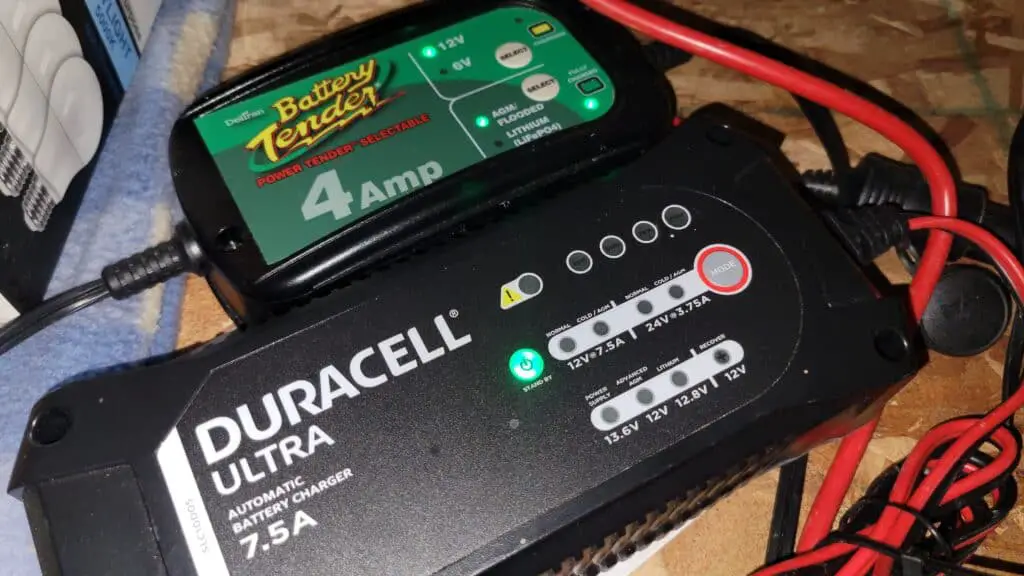
Choosing the correct size charger is important because a battery can only convert electrical energy into stored chemical energy at a certain rate at any given time. The higher the state of charge of a battery, the more reluctant it is to accept a charge. The more depleted a battery is, the faster it will accept it.
If you have a 50Ah car battery and attempt to use a 25-amp charger, the charger is essentially trying to fill the battery up at 25Ah per hour (not considering inefficiencies) and should (in theory) take 2 hours to charge if the battery was completely drained to begin with.
However, if the battery can only convert 5 of those amps per hour into stored chemical energy, then the other 20 amps being pumped into it will have to be dealt with. What happens with the excess amperage is that it is released as heat. The extra 20 amps (in this example) will pass through the electrolyte and since they aren’t being used in the chemical reaction for storing energy in the battery’s plates, they will engage in electrolysis of the electrolyte.
With electrolysis, the excess electricity is breaking apart the water and sulfuric acid molecules inside the electrolyte. This generates a lot of heat. The electrolyte begins to boil, steam gets trapped inside the battery’s case until pressures get too high and finally the steam will have to vent out of the battery somewhere. At first glance, it looks like your battery is smoking. In this case, it’s actually steam.
The same process can happen if your battery is already at 100% of charge and your charger (usually an antiquated charger from decades ago) will not turn off and keeps pumping in current. Obviously the battery cannot accept the current because there is no longer the possibility of a chemical reaction in the battery with a 100% state of charge.
Electrolysis will occur and once the pressures build up high enough you’ll see steam being released from the battery.
This is why in the past the old “trickle chargers” without a “float” or “maintenance” mode could easily boil out all of your electrolyte and kill your battery within a few days to a few weeks depending on the charging current. Back then you had to carefully estimate the charging time based on the starting voltage and remove the charger when finished.
How to Fix: Use a properly sized smart charger for your battery (4 to 10-amps) that has a “float” or “maintenance” mode.
2.) Low Electrolyte (Flooded Batteries Only)
Low electrolyte levels that expose the plates inside the battery to air can also lead to a smoking (steaming) battery. In this case, the lead plates should always be covered with electrolyte or they will instantly (and permanently) corrode when exposed to air.
Lead sulfate crystals will form on the plates when exposed to air. This is basically a white coating that will inhibit the battery’s plates from accepting a charge and from discharging properly as well. You’ll lose cranking power when trying to turn over your engine and it’ll take longer to charge.
The issue with the steam arises when the battery is trying to be charged be a dedicated charger or by the car’s alternator. The current going into the battery is experiencing internal resistance withing the cells that have low electrolyte levels. Resistance in this case leads to heat build up and then we’re experiencing the electrolysis issue that we talked about above (see the highlighted section and the paragraph before it).
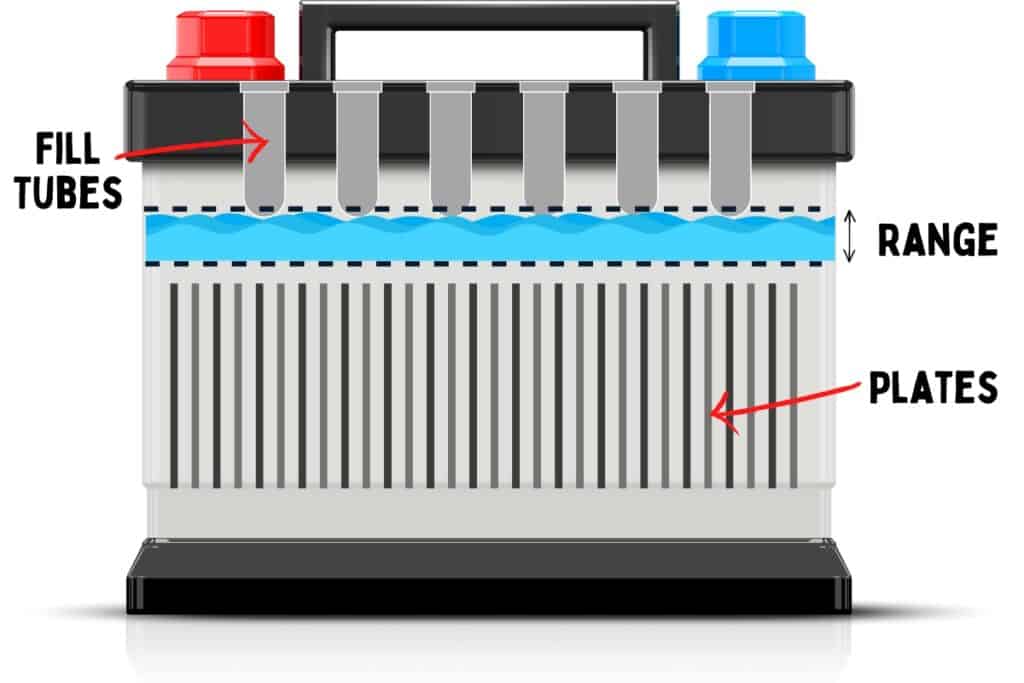
So even though your charger (or alternator) might be properly sized for the battery, the fact that battery’s plates are compromised by lead sulfate crystals mean that even a normal charging current is treated like an overcharge because the lead sulfate crystals inhibit the chemical reactions inside the battery.
How to Fix: If your battery is sealed (no fill caps), then there is nothing to do since you cannot access the cells. If you have a flooded battery where you can pop off the caps from the top of the battery, add just enough distilled water to completely cover the plates if they are exposed to air. Connect to a properly-sized smart charger and charge completely. When finished, add more distilled water until you’re just touching the bottom of the fill tube for all of the cells. If your charger has a desulfation feature, you can now attempt to run that to try to partially recover any damage caused by the plates being exposed to air. If the damage is too bad already, you may need a new battery.
3.) Alternator / Voltage Regulator Malfunctioning
When your car’s engine is running, it uses a voltage regulator (computerized on new cars) and an alternator to charge the battery. This is done most efficiently and effectively at driving speeds and not at idle.
As long as everything is working fine and you drive for a long enough period (more than 15 minutes at highway speeds) then your battery should remain relatively healthy.
Pro Tip: If you typically commute for short distances at low speed, your alternator never has the time required to fully charge your battery after your battery spends a lot of its energy trying to turn over your engine and powering all the car’s electronics. The state of charge will drop more and more with each trip, sulfation will build up on the plates, and your battery will have a short life. Make sure to regularly hook your car up to a smart charger at home to keep your battery from dying prematurely.
What happens if the alternator or the voltage regulator malfunction? In this case the could either undercharge your battery or overcharge it. If it undercharges you won’t see smoke (steam), but if it overcharges it then you can.
Again, refer to the highlighted paragraph (and the one before it) in the first section of this article to understand what is happening when your battery is being overcharged and why you’re seeing smoke (steam).
How to Fix: Typically, an alternator will charge between 13.8 and 14.8 volts. If your gauge on your dashboard shows 15+ volts or if you check your battery’s terminals with a multimeter with the car running and see a reading of 15+ volts, then you should have your mechanic make sure that the alternator and voltage regulator are working properly. You’ll also almost certainly be experiencing other issues like the engine stalling and problem with your lights and electronics if this is the issue.
4.) Overly-Sulfated Battery
We already touched on this topic in the section above regarding low electrolyte, since low electrolyte levels will cause sulfation inside a battery.
Sulfation really starts to take hold in a battery whenever its state of charge is 80% or less (12.5 volts). The lower the voltage from that point, the faster the sulfation will build up, so it’s a vicious cycle. Without a charger to intervene (or driving), once a car battery starts sulfating it will sulfate faster and faster until the battery is dead.
Sulfation usually happens if you take short commutes since the alternator never has the time to fully recharge the battery after it starts your engine, or if your battery is old. A battery can only go through so many discharging cycles and recharging cycles before it builds up enough gradual sulfation from all of the discharges and is rendered ineffective. Typically, a car battery will have a lifespan of 5-7 years with normal use.

As a recap, sulfation in a battery is the buildup of lead sulfate crystals on the battery’s plates and this coating makes it difficult to charge the battery and also difficult for the battery to release electricity when needed. This creates internal resistance in the battery and high internal temperatures. The electrolyte will begin to boil with the increased heat and when the pressures build high enough you’ll see smoke (steam) rising up from the top.
How to Fix: If your battery is less than 5 years old, you can try hooking it up to a charger with a “desulfation”, “equalization” or “recovery” mode. This is when the charger uses a high pulsating current for several hours to conduct a controlled overcharge of your battery in an attempt to dislodge and remove as many of the lead sulfate crystals as possible from the plates. A younger battery will gain the most from this process as the sulfation isn’t as permanent. You can try this with a battery that is older than 5 years but you’ll likely only buy yourself a little time. A new battery is probably required.
5.) Very High Ambient Temperatures
Lead acid batteries perform decently in temperature extremes but they still suffer quite a bit — especially in extreme heat.
Cold temperatures make it hard for a battery to accept a charge (and be used) since the chemical reaction is slower. Warmer temps allow the battery to charge (and be used) at a normal rate. Hot temperatures allow a battery to charge and discharge faster than is good for them.
In the case of hot temperatures, the engine can’t cool fast enough and the electrolyte temperatures inside the battery will rise. The chemical reaction to recharge the battery by the alternator can happen faster than the battery was designed for. When using normal charging voltages at high temperatures, the electrolyte will begin to boil and you can see steam venting out as the pressures build up.
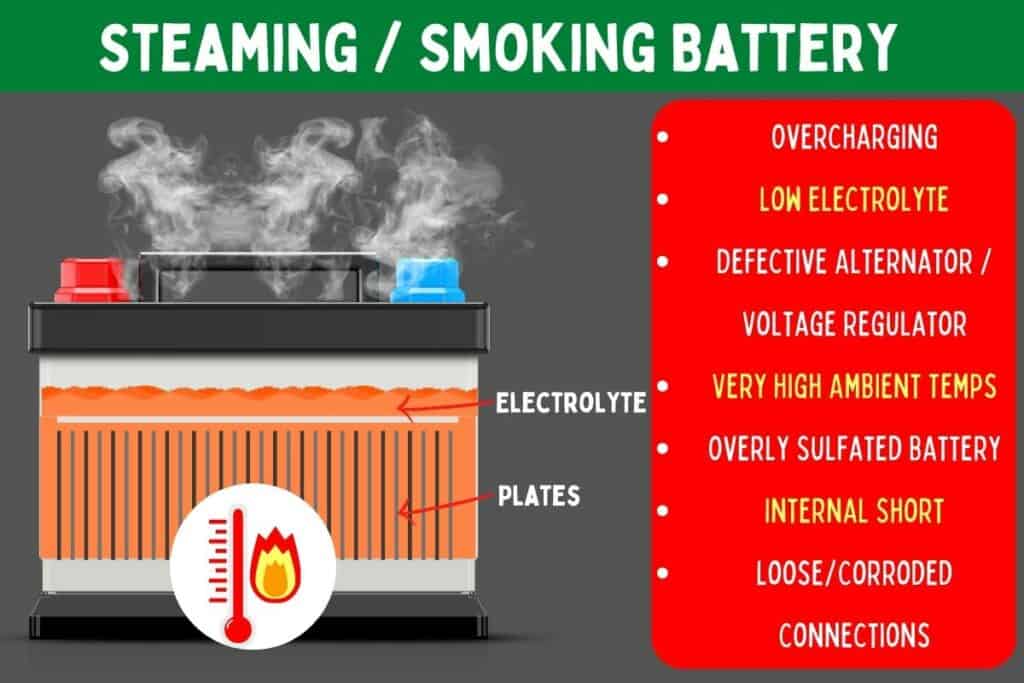
Ideally, the charging voltage should be reduced more and more when the temperatures start climbing above 85-90°F (29.4-32.2°C). Newer cars have alternators that will adjust for hot and cold ambient temperatures, reducing and increasing the charging voltages respectively.
How to Fix: Consider purchasing an AGM battery if you’re in an area with temperatures regularly above 85-90°F. While more expensive, they do hold up better in hot temperatures.
6.) Internal Short
Hitting potholes in the road or any other jarring action can damage your battery internally. If a weld fails or if anything conductive breaks or moves due to shock damage, it can easily cause an internal short if the conductive piece creates a bridge between two or more of the plates inside the battery.
In this case, your battery will rapidly discharge itself and will not be able to hold a charge if you were to try.
As it rapidly discharges, the electrolyte will boil, pressure will build, and eventually smoke (steam) will be visible from the battery.
If you’ve ever put steel wool up to a 9-volt battery or used a metallic gum wrapper to touch both sides of a AA battery, you know that heat (and fire) is immediately generated. This is essentially what is happening inside the battery but since it’s in liquid it will boil and steam.
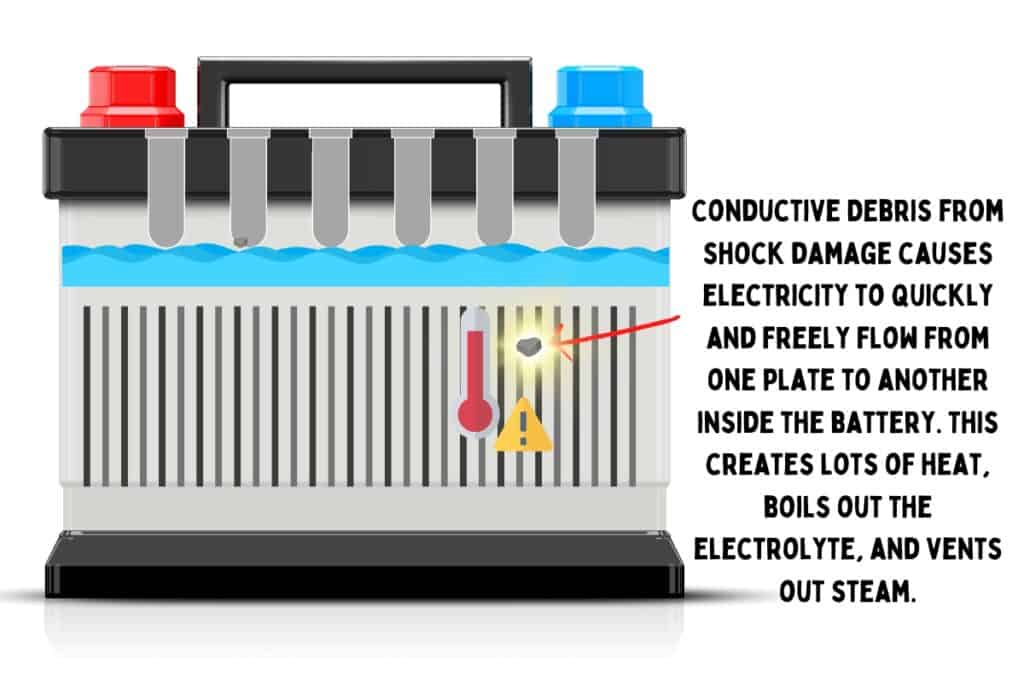
In the event of charging a battery with an internal short, you can also see smoke (steam). Many modern chargers can detect a defective battery, but if it’s not immediately detected then the charger will do its best to bring the voltage of the entire battery up to 12.7. Remember, a 12v battery has 6 internal cells that should ideally be around 2.1 volts each.
If one cell is shorted out and won’t hold a charge, it’s voltage will effectively be zero.
The charger will then overcharge the other 5 cells to try to raise their totals up to 2.5+ to reach the 12.7 total for the entire battery. This overcharging will result in electrolysis again which will boil out their electrolyte as well, increase pressures, and they’ll release visible steam.
How to Fix: A new battery is required. It will be apparent that you have a short (or just a bad battery for other reasons) if the battery will not hold a charge or if the charger times itself out without ever reaching a full charge. You can also tell if one cell’s electrolyte levels are significantly and constantly lower than the others.
7.) Loose Connections / Terminal Corrosion
Instead of steam, a loose battery connection or a corroded terminal is a perfect example of where you may actually be seeing smoke rising up from your battery.
Both instances cause higher resistance and can cause arcing as well (which is where you would have sparks as the electrons try to complete the circuit through the air gap between the cables and the terminals.
Either way, excess heat is definitely created at these locations and they can easily burn you if you touch them.
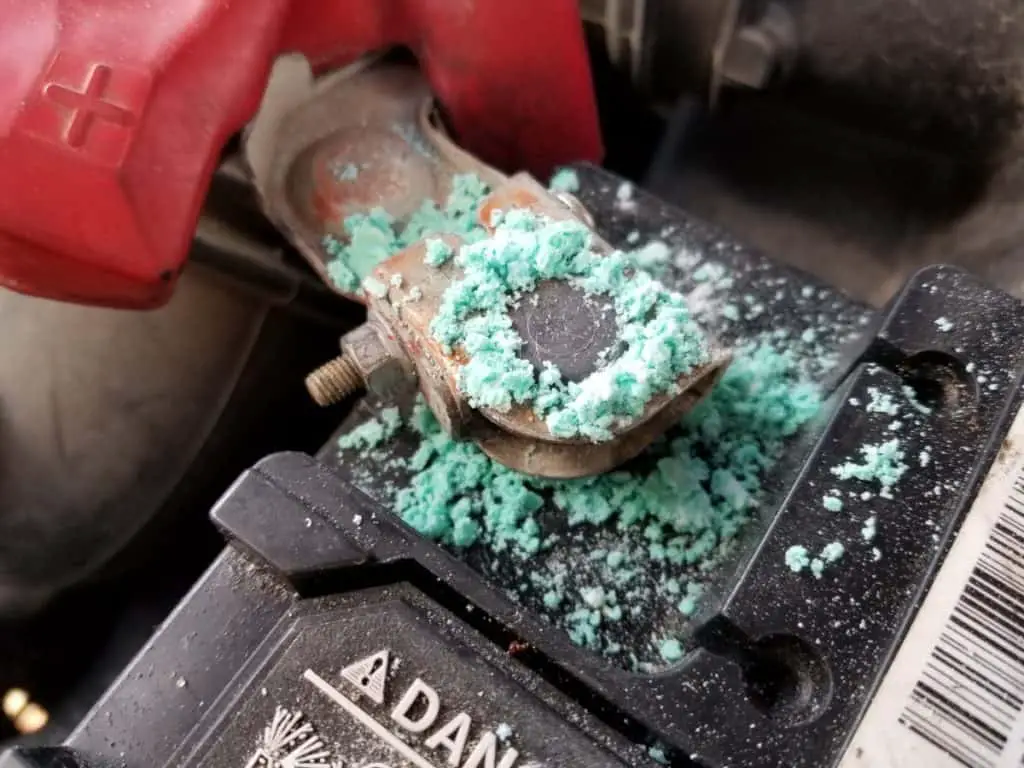
In fact, they can get so hot that they’ll heat up and melt the plastic casing around the terminal or the insulation of the cable attaching to it and this will result in black smoke.
How to Fix: Replace the battery if the case is damaged from being melted. Replace any cables as needed. Remove the cables from the battery terminals and clean the terminals of corrosion using an old toothbrush and slurry made from baking soda and water. Wipe clean and reattach the cables. Ensure that they are tight by trying to wriggle them free afterward.

